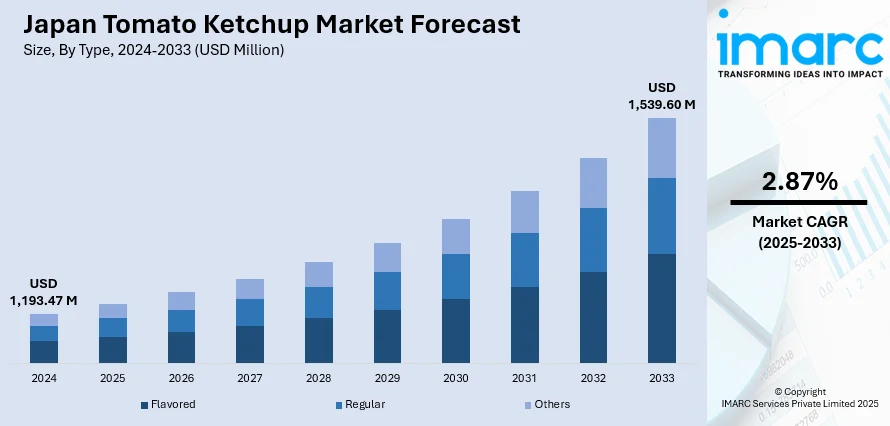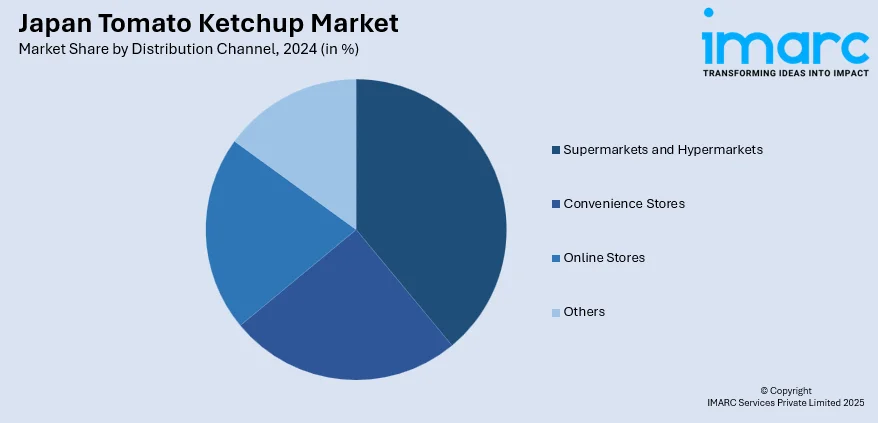
Japan Tomato Ketchup Market Size, Share, Trends and Forecast by Type, Packaging, Distribution Channel, Application, and Region, 2025-2033
Japan Tomato Ketchup Market Overview:
The Japan tomato ketchup market size reached USD 1,193.47 Million in 2024. Looking forward, IMARC Group expects the market to reach USD 1,539.60 Million by 2033, exhibiting a growth rate (CAGR) of 2.87% during 2025-2033. The market is experiencing steady growth due to the shifting consumer preferences toward clean-label and healthier condiments, resulting in increasing demand for low-sugar, organic, and natural ingredient ketchups. This trend also reflects a wider shift toward plant-based eating and sustainable food choices, thus contributing to the Japan tomato ketchup market share.
|
Report Attribute
|
Key Statistics
|
|---|---|
|
Base Year
|
2024 |
|
Forecast Years
|
2025-2033
|
|
Historical Years
|
2019-2024
|
| Market Size in 2024 | USD 1,193.47 Million |
| Market Forecast in 2033 | USD 1,539.60 Million |
| Market Growth Rate 2025-2033 | 2.87% |
Japan Tomato Ketchup Market Trends:
Clean Label Movement and Health-Conscious Innovation
One of the major trends defining the Japan tomato ketchup industry is the shift toward health-conscious and clean-label products driven by consumer demand. As consumer awareness about health and wellness improves, they are looking for ketchups that are lower in sugar content, lower in salt content, and do not contain artificial preservatives or additives. This has encouraged manufacturers to redefine classic ketchup recipes using natural sweeteners such as fruit extracts, organic tomatoes, and substitute seasonings in order to preserve taste with added nutritional values. This shift further aligns well with Japan's overall culture of food safety and health in which ingredient openness and sourcing openness are greatly preferred. Producers have responded accordingly by highlighting traceability and domestic sourcing in a bid to restore trust among consumers. While this movement greatly transforms product creation, it is also impacting brand development and promotional strategies, whereby "natural," "additive-free," and "organic" are emerging as the most preferred themes for packaging and promotional messages.

Fusion Flavors and Culinary Customization
Japanese consumers have a taste for adventure and an appreciation of complexity of flavor, which is fueling a trend toward fusion and tailored ketchup styles. Classic tomato ketchup is being redefined with the addition of local ingredients like yuzu, wasabi, miso, and shiso, reflecting local tastes and providing distinctive dining experiences. These new products are being positioned as multifunctional cooking ingredients, stimulating innovative home cooking and restaurant use. Moreover, customization is another significant factor with some manufacturers offering bespoke ketchup blends or small-batch artisanal versions where consumers can contribute to flavor design. This follows Japan's general gastronomic culture, which prizes precision, craftsmanship, and uniqueness. Additionally, the growth of premium and gourmet food segments is further propelling demand for specialist ketchups that are different from mass-market ketchups. Through blending conventional ketchup performance with essentially Japanese taste profiles, brands are drawing attention from quality-conscious consumers who look for novelty and authenticity, further fueling the Japan tomato ketchup market growth.
Sustainability and Local Sourcing Initiatives
Sustainability is increasingly emerging as a prominent driver in the Japanese tomato ketchup market, affecting product development, packaging, and supply chains. Customers and regulatory authorities are increasingly shifting toward environmentally sustainable production, which is pressurizing companies to pursue green practices along the value chain. This encompasses locally sourced, pesticide-free tomatoes, sustainable farming methods, and biodegradable or recyclable packaging materials. Manufacturers are also investing into energy-efficient production processes and minimizing food wastage through better yield management and byproduct usage. These eco-friendly initiatives are frequently promoted in product branding, further reinforcing consumer loyalty and confidence. Regional farming collaborations are also being encouraged to enhance local agriculture, providing fresher inputs and enhancing community-based economic growth. These practices are well-received within the Japanese market's focus on quality, regionality, and environmental conservation. As sustainability emerges as a competitive edge, brands that are successful in embedding such values into ketchup products are poised to witness sustained consumer loyalty and regulatory acceptability.
Japan Tomato Ketchup Market Segmentation:
IMARC Group provides an analysis of the key trends in each segment of the market, along with forecasts at the country and regional levels for 2025-2033. Our report has categorized the market based on type, packaging, distribution channel, and application.
Type Insights:
- Flavored
- Regular
- Others
The report has provided a detailed breakup and analysis of the market based on the type. This includes flavored, regular, and others.
Packaging Insights:
- Pouch
- Bottle
- Others
A detailed breakup and analysis of the market based on the packaging has also been provided in the report. This includes pouch, bottle, and others.
Distribution Channel Insights:

- Supermarkets and Hypermarkets
- Convenience Stores
- Online Stores
- Others
The report has provided a detailed breakup and analysis of the market based on the distribution channel. This includes supermarkets and hypermarkets, convenience stores, online stores, and others.
Application Insights:
- Household
- Commercial
- Others
A detailed breakup and analysis of the market based on the application has also been provided in the report. This includes household, commercial, and others.
Regional Insights:
- Kanto Region
- Kansai/Kinki Region
- Central /Chubu Region
- Kyushu-Okinawa Region
- Tohoku Region
- Chugoku Region
- Hokkaido Region
- Shikoku Region
The report has also provided a comprehensive analysis of all the major regional markets, which include Kanto Region, Kansai/Kinki Region, Central /Chubu Region, Kyushu-Okinawa Region, Tohoku Region, Chugoku Region, Hokkaido Region, and Shikoku Region.
Competitive Landscape:
The market research report has also provided a comprehensive analysis of the competitive landscape. Competitive analysis such as market structure, key player positioning, top winning strategies, competitive dashboard, and company evaluation quadrant has been covered in the report. Also, detailed profiles of all major companies have been provided.
Japan Tomato Ketchup Market News:
- In November 2024, the cherished and renowned Japanese Nintendo character Kirby partnered with Heinz for a fun and imaginative collaboration. This unique series showcased Kirby-themed pouch-style tomato ketchup, adorned with charming illustrations of Kirby relishing his beloved meals like omelets and tomatoes.
Japan Tomato Ketchup Market Report Coverage:
| Report Features | Details |
|---|---|
| Base Year of the Analysis | 2024 |
| Historical Period | 2019-2024 |
| Forecast Period | 2025-2033 |
| Units | Million USD |
| Scope of the Report |
Exploration of Historical Trends and Market Outlook, Industry Catalysts and Challenges, Segment-Wise Historical and Future Market Assessment:
|
| Types Covered | Flavored, Regular, Others |
| Packagings Covered | Pouch, Bottle, Others |
| Distribution Channels Covered | Supermarkets and Hypermarkets, Convenience Stores, Online Stores, Others |
| Applications Covered | Household, Commercial, Others |
| Regions Covered | Kanto Region, Kansai/Kinki Region, Central /Chubu Region, Kyushu-Okinawa Region, Tohoku Region, Chugoku Region, Hokkaido Region, Shikoku Region |
| Customization Scope | 10% Free Customization |
| Post-Sale Analyst Support | 10-12 Weeks |
| Delivery Format | PDF and Excel through Email (We can also provide the editable version of the report in PPT/Word format on special request) |
Key Questions Answered in This Report:
- How has the Japan tomato ketchup market performed so far and how will it perform in the coming years?
- What is the breakup of the Japan tomato ketchup market on the basis of type?
- What is the breakup of the Japan tomato ketchup market on the basis of packaging?
- What is the breakup of the Japan tomato ketchup market on the basis of distribution channel?
- What is the breakup of the Japan tomato ketchup market on the basis of application?
- What is the breakup of the Japan tomato ketchup market on the basis of region?
- What are the various stages in the value chain of the Japan tomato ketchup market?
- What are the key driving factors and challenges in the Japan tomato ketchup market?
- What is the structure of the Japan tomato ketchup market and who are the key players?
- What is the degree of competition in the Japan tomato ketchup market?
Key Benefits for Stakeholders:
- IMARC’s industry report offers a comprehensive quantitative analysis of various market segments, historical and current market trends, market forecasts, and dynamics of the Japan tomato ketchup market from 2019-2033.
- The research report provides the latest information on the market drivers, challenges, and opportunities in the Japan tomato ketchup market.
- Porter's five forces analysis assist stakeholders in assessing the impact of new entrants, competitive rivalry, supplier power, buyer power, and the threat of substitution. It helps stakeholders to analyze the level of competition within the Japan tomato ketchup industry and its attractiveness.
- Competitive landscape allows stakeholders to understand their competitive environment and provides an insight into the current positions of key players in the market.
Need more help?
- Speak to our experienced analysts for insights on the current market scenarios.
- Include additional segments and countries to customize the report as per your requirement.
- Gain an unparalleled competitive advantage in your domain by understanding how to utilize the report and positively impacting your operations and revenue.
- For further assistance, please connect with our analysts.
 Request Customization
Request Customization
 Speak to an Analyst
Speak to an Analyst
 Request Brochure
Request Brochure
 Inquire Before Buying
Inquire Before Buying




.webp)




.webp)












